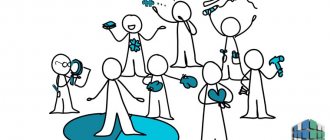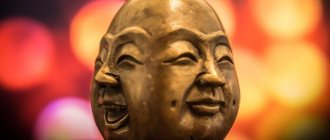| Kind of work: | Essay |
| Date added: | 21.01.2020 |
- This type of work is not a scientific work, it is not a finished final qualifying work!
- This type of work is a finished result of processing, structuring and formatting collected information intended for use as a source of material for independent preparation of educational work.
If you have a hard time understanding this topic, write to me on WhatsApp, we’ll look into your topic, agree on a deadline, and I’ll help you!
If you want to learn how to correctly carry out and write abstracts on any subject, then on the page “what is an abstract and how to do it” I wrote in detail.
Introduction
Each person differs from each other in his individual psychological characteristics. In this sense, in ordinary language we talk about qualities characteristic of a particular person.
Character - this concept initially contains a complex internal dialectic. We use it to define human individuality, what sets a particular person apart from everyone else, what makes him unique. At the same time, in this uniqueness we also assume similarities with other people. The word “character” is used by us constantly and everywhere; it is necessary and fulfills its purpose.
In psychology, the concept of character is understood as a set of individual and unique psychological qualities that manifest themselves in typical forms of personal activity, are found in typical circumstances and are determined by the individual’s attitude to these circumstances.
Character is not inherited and is not an innate quality of a person, nor is it a permanent and unchangeable quality. Character is formed and developed under the influence of the environment, life experience, and a person’s education. These influences are, firstly, social and historical (each person lives in a certain historical system, a certain social environment and is formed as a person under their influence), and secondly, individually distinctive (the living and working conditions of each person, his life the path is unique and inimitable). Therefore, the character of each person is determined by both his social and individual nature.
As a result, there is an endless variety of individual characters. However, in the life and activities of people living and developing in the same conditions, there is much in common, therefore their character will also contain some common aspects and features that reflect general, typical aspects of their life.
Bibliography
1. Vygotsky L.S. Pedagogical psychology. – L., 1983.
2. Enikeev M.I. General and legal psychology (in two parts). Part I “General psychology”. Textbook. – M.: Legal. lit., 1996.
3. Kovalev A.G., Myasishchev V.N. Psychological characteristics of a person. T. 1. Character. – L., Leningrad State University Publishing House, 1958.
4. Brief psychological dictionary / Ed. A.V. Petrovsky and M.G. Yaroshevsky. – M., 1985.
5. Krutetsky V.A. Psychology. – M.: Education, 1986.
6. Levitov N.D. Psychology of character. 3rd ed. – M., Education, 1964.
7. Leongard K. Accentuated personalities. – Kyiv, 1981.
8. Leontyev A.N. Problems of mental development. – M., 1965.
9. Lichko A.E. Psychopathy and character accentuations in adolescents. – L., 1983.
10. Nemov R.S. Psychology. – M.: Education, 1990.
11. Nemov R.S. General psychology: Textbook. for students education institutions prof. education. – M., 2003.
12. General psychology: Textbook for students of pedagogy. Institute / A.V. Petrovsky, A.V. Brushlinsky, V.P. Zinchenko and others; Ed. A.V. Petrovsky. – M.: Education, 1986.
Attention!
If you need help writing a paper, we recommend turning to professionals. More than 70,000 authors are ready to help you right now. Free adjustments and improvements. Find out the cost of your work
Free estimate
+1
Size: 24.82K
Downloads: 118
11/18/14 at 05:17 pm Author: Portugal
Liked? Click on the button below. It's not difficult for you
, and we
are pleased
).
To download Abstracts for free at maximum speed, register or log in to the site.
Important! All presented Abstracts for free downloading are intended for drawing up a plan or basis for your own scientific works.
Friends! You have a unique opportunity to help students just like you! If our site helped you find the job you need, then you certainly understand how the job you add can make the work of others easier.
Add a job
If, in your opinion, the Abstract is of poor quality, or you have already seen this work, please let us know.
Concept of character
In Greek, “character” is “mintage,” “sign.” Indeed, character is a special quality that a person acquires while living in society. Just as personality is expressed through the characteristics of the mental process (good memory, vivid imagination, quick mind, etc.) and character traits, it also manifests itself in character traits.
Character is a set of stable individual personality traits that develop and manifest themselves in activity and communication and cause typical forms of individual behavior.
A person's personality is characterized not only by what he does, but also by how he does it. Acting on the basis of common interests and beliefs, striving for common goals in life, people can find in their social behavior, actions and deeds not the same, sometimes opposite, individual characteristics.
You can experience the same difficulties with other people, perform your duties equally well, like or dislike the same things, but be soft, pliable or hard, intolerant, happy or sad, confident or shy, cheerful or uncooperative.
Criticism of students is always expressed by some teachers in a gentle, polite, friendly manner, while others express it in a cruel and merciless manner. Differences in values, interests, culture and morals between students tend to be even more pronounced.
These individual traits that make up a person's character relate primarily to the will (for example, determination or uncertainty, timidity) and emotions (for example, cheerfulness or depression), but also partly to the mind (for example, frivolity or thoughtfulness).
Character reveals dependence on social attitudes that determine the orientation of the human personality. For example, in a society based on the exploitation of man by man, the social position of representatives of the ruling classes helps to cement arrogance, vanity, hypocrisy, selfishness, and so on in their character.
Character formation occurs under conditions of a person’s involvement in various stages of development of social groups (in the family, in a friendly society, in a work or educational team, in an asocial association, etc.). Depending on how a person’s individualization occurs in his reference group and the level of development of interpersonal relationships in it, young people can develop, for example, in one case openness, frankness, courage, adherence to principles, strength of character, in another - secrecy, deceit, cowardice, conformism, weak character traits.
A group with a high level of development provides the most favorable conditions for the development and consolidation of the best qualities of character. This process contributes to the optimal integration of the individual into the team and the further development of the team itself.
Conclusion:
Character is a set of stable individual personality traits that develops and manifests itself in activity and communication, causing typical human behavior.
Knowing a person's character, we can predict how he will behave under certain circumstances, and thus control the person's behavior. Starting with the valuable qualities of the student’s character, the teacher tries to develop and strengthen them and weaken the negative ones, or at least compensate for them with other socially significant qualities.
Character and its classification
Character consists of stable traits that explain the behavior and characteristics of a person’s activities. The typology of a person’s character is manifested in his work, communication with people, and handwriting.
Manifestation of character in communication
In psychology, there are several scientific approaches to understanding character:
- Constitutional biological approach. The founder of this concept is E. Kretschmer. According to his views, character is a combined combination of a person’s physique and temperament.
- Psychoanalytic approach. This characterological theory was developed by the masters of psychoanalysis Z. Freud, K.G. Jung and A. Adler. They explained manifestations of character by the presence of unconscious drives in a person.
- Ideological approach. The author of this concept is Robeck, who believed that character is formed as a result of the fact that a person subordinates his desires to the established rules and norms of society. In addition, Robek believed that the social position of an individual largely determines his characterological traits.
While studying character structure, B.G. Ananyev identified in it such components as personality orientation, level of development of communication skills, habits, and features of the emotional-volitional sphere.
N.D. Levitov believed that character is formed on the basis of a person’s attitude to society and other people, to himself and his activities, things.
The similarity of different approaches is seen in the fact that all researchers confidently stated that character depends on a person’s living conditions and his temperament. The basis of character is made up of stable traits that a person can accept and be aware of, or may deny or not be aware of.
Attention! Unlike the type of temperament, character is not an innate property of a person; it is formed in the process of life
Character traits
The most objective and irrefutable data about a person’s character is provided not by his passport data, not by his external signs, not by his involuntary actions, but by conscious behavior. That is, what possible actions a person chooses in a given situation judges his character. Human character is very complex.
This is already visible in the process of activity:
- one person does everything quickly,
- the other slowly and carefully, thinks and acts confidently,
- and the third one immediately grabs it without hesitation, and only after a while, without solving the problem on the spot, he looks around and coordinates his actions with the circumstances.
These traits that stand out in human behavior are called character traits or aspects of character. Each trait is a special stable stereotype of behavior.
However, character traits cannot be removed from the typical situations in which they occur; In some situations, even a polite person can be rude. Therefore, each character trait is a stable form of behavior associated with certain situations characteristic of a given type of behavior.
Motives of behavior that are realized in action are fixed in it, fixed in character. Any motive of action that gains stability, according to S.L. Rubinstein, is, in its potential, a future character trait in its formation and development; in motives, character traits first appear in the form of tendencies, action then leads them to stable characteristics. Thus, the path to the formation of character traits lies through the formation of appropriate behavioral and organizational motives aimed at consolidating them in action.
The most common character traits are located on the axis:
- strength - weakness;
- hardness - softness;
- integrity - inconsistency;
- breadth - narrowness.
If strength of character is understood as the energy with which a person pursues his goals, his ability to be passionate and develop great strength when faced with difficulties, the ability to overcome them, weakness of character is associated with the manifestation of cowardice, indecisiveness, “asthenia” in achieving goals, instability of moods and etc.
Strength of character means strict consistency, persistence in achieving goals, maintaining views, etc., while softness of character is expressed in flexible adaptation to changing conditions, achieving goals through certain concessions, and finding a reasonable compromise.
The integrity or inconsistency of character is determined by the degree of combination of leading and secondary character traits. If the leading and secondary traits are harmonious, if there are no contradictions in aspirations and interests, then such a character is called integral, and if they sharply contrast, then inconsistent.
In this case, the unity and versatility of nature does not exclude the fact that in different situations with the same person there are different and even opposite qualities. A person can be both very gentle and very demanding, gentle, pliable and at the same time difficult to yield. And the unity of his character can not only remain, but also manifest itself.
The interconnection of intellectual personality traits is of great importance for the expression of character. Depth and sharpness of thinking, unusual questions and their solutions. Intellectual initiative, confidence and independence of thought all make originality of mind an aspect of character.
However, how a person uses his mental abilities largely depends on his character. It is often possible to meet people who are highly intelligent, but have nothing valuable precisely because of their character traits.
A person's real achievements depend not only on his intellectual abilities, taken in abstract form, but also on the specific combination of his idiosyncrasies and character traits.
However, most of the individual manifestations that make up a person’s character are complex and can hardly be classified into individual qualities and states (for example, vindictiveness, mistrust, generosity, etc.). At the same time, individual qualities from the volitional sphere (determinism, independence, etc.) and the intellectual sphere (depth of mind, critical abilities, etc.) can be considered as constituent character traits of a person and used for their analysis. All character traits are regularly related to each other.
In the most general form, character traits can be divided into main leading ones, which give the general direction for the development of the entire complex of their manifestations, and secondary ones, which are determined by the main ones.
Knowing the basic traits allows us to reflect the essential nature of character and show its main manifestations. Although each character trait reflects one of the manifestations of a person's attitude towards reality, this does not mean that every attitude is a character trait. Only some attitudes, depending on the conditions, become character traits.
From the totality of a person’s relationships to the surrounding reality, it is necessary to highlight the relationships that form character, which acquire decisive, primary and generally vital importance for the objects with which a person is connected. These connections also serve as the basis for classifying the most important character traits. A person’s character is manifested in a system of relationships:
- In behavior with other people (in this case, one can distinguish such character traits as sociability - restraint, truthfulness - falsehood, tactfulness - rudeness, etc.).
- In relation to business (responsibility - dishonesty, hard work - laziness, etc.).
- In relation to oneself (modesty - narcissism, self-criticism - self-confidence, etc.).
In relation to property (generosity - greed, frugality - wastefulness, neatness - sloppiness, etc.). It is necessary to note some conventionality of this classification and the close relationship and interpenetration of these aspects of the relationship.
Although these relationships are the most important in terms of character formation, they do not become character traits all at once. There is a certain sequence in the transition of these relations to character traits, and in this sense, for example, the attitude towards other people and the attitude towards property cannot be put on the same level, because the content of these relations plays a different role in the real existence of a person. A person’s attitude towards society and people plays a decisive role in the formation of character. The character of a person cannot be revealed and understood outside the team without taking into account his connections in the form of communication, friendship, love, etc.
A person's relationships with other people act as a determining factor in terms of activity and lead to increased activity, tension, rationalization or, conversely, to complacency and lack of initiative. In turn, the attitude towards other people and towards activity determines the person’s attitude towards his own personality, towards himself. Correct, valued attitude towards another person is the main condition for self-respect.
Attitude towards other people is not only an important part of character, but also forms the basis for the formation of a person’s consciousness, which necessarily includes an attitude towards oneself as an actor, which depends, first of all, on the form of the activity itself. When an activity changes, not only the object, methods and procedures of this activity change, but also the attitude towards oneself as an actor.
Conclusion:
Character is a set of stable individual personality traits that develop and manifest themselves in activity and communication and are the cause of an individual’s typical behavior.
The most common character traits are located along the axes of strength and weakness, hardness and softness, integrity and inconsistency, breadth and narrowness.
Using knowledge about character in the practice of professional communication among police officers
Employees of internal authorities in the practice of professional communication can use character typologies created by K. Leonhard and A. Lichko.
German psychiatrist K. Leongard and Russian psychiatrist A. Lichko in the middle of the 20th century. offered their typologies of people's characters. Leonhard extended the typology he created to adults, and Lichko addressed it to teenagers and young men. Both doctors based their typology on the idea of typical cases of manifestation of accentuated character traits in people, and the descriptions and terminological definitions of the corresponding character types by both authors are quite close.
K. Leonhard identified 12 types of accentuated characters, which are often found in people suffering from various neuroses. These are the following types:
1. Hyperthymic type. It is characterized by increased sociability, emotionality, violations of the logic of thinking (frequent deviations during the conversation from the initial topic of communication), frequent conflicts with
surrounding people due to a frivolous attitude towards their responsibilities. The most common negative character traits of this type of people are the following: frivolity, a tendency to immoral acts, increased irritability, projectism. At the same time, people of this type are characterized by the following positive character traits: energy, initiative, optimism.
2. Dysthymic type. He is characterized by unsociability, taciturnity, a prevailing bad mood, avoids noisy companies, prefers to be alone, to be at home, to lead a secluded lifestyle, rarely
comes into conflict with people around him. Along with this, he highly values friendship, is serious, fair and conscientious.
3. Cycloid type. Characterized by frequent, periodic changes in mood and manner of communicating with people. During periods of good mood, people of this type are sociable and kind, and during periods of bad mood they are withdrawn and angry.
4. Excitable type. He gets excited quickly, often loses his temper, is prone to rudeness, and in conflicts with people he is an active, provoking party. He is often irritable, gloomy, and unsociable. In a normal state, he has a number of positive character traits: conscientiousness, accuracy, loves animals and small children.
5. Stuck type. He is characterized by a penchant for moralizing, inflexibility of thinking and stubbornness. In conflicts he is often an active party, an initiator. Touchy, suspicious and vindictive.
Sometimes he is overly arrogant and makes exorbitant demands on people. May have the following positive traits: fairness, desire for good results at work.
6. Pedantic type. He behaves like a bureaucrat, making many purely formal demands on people. Sometimes he harasses his family with excessive claims to neatness. His attractive character traits: conscientiousness, accuracy, reliability and responsibility in business.
7. Anxious type. Unconfident, timid and uncommunicative, with a predominance of bad mood. Rarely conflicts with people around him, acting in conflicts mainly in a passive role. Often has the following positive character traits: friendliness, self-criticism, conscientiousness, diligence. Such people, due to their insecurity, are often targets for jokes, “scapegoats.”
8. Emotive type. Overly emotional, tearful. Has a fairly narrow, limited circle of contacts. However, such a person understands the people with whom he communicates closely. Rarely enters into conflicts with others, and carries grievances within himself. Positive character traits: kindness, compassion for people, sense of duty, diligence.
9. Demonstrative type. Self-confident, has inflated claims, provokes conflicts, but at the same time he defends himself more actively if he is attacked. Characterized by ease in establishing contacts, a desire for Leadership, a thirst for power and praise. He is often selfish, hypocritical, boastful, and shirks from work. He also has the following positive character traits: courtesy, the ability to captivate other people, artistry, originality of actions and thinking.
10. Exalted type. He is distinguished by high contact and sociability, talkativeness and amorousness. Attached and attentive to friends and loved ones. Often gets into arguments with people, but does not lead to conflict. Subject to momentary moods and panic. Other positive characteristics: has good taste, shows compassion for people, has sincere feelings.
11. Extroverted type. He is highly contactable and has a lot of acquaintances and friends. He is talkative and shows interest in everything. Rarely enters into conflicts with other people while playing them
usually a passive role. He does not claim leadership, conceding it to other people, prefers to obey others and be in the shadows. Unpleasant character traits: frivolity, thoughtlessness of actions, susceptibility to the influence of other people, passion for entertainment, participation in the spread of rumors and gossip. Has such positive character traits as attention to people, willingness to listen, help, and diligence.
12. Introverted type. Characterized by isolation, low contact, and a tendency to philosophize, divorced from reality. He loves loneliness, rarely comes into conflict with people around him, and only when someone tries to unceremoniously interfere in his life. Negative character traits: stubbornness, inflexibility of thinking, persistent defense of one’s own, not always correct, ideas. He also has such attractive character traits as restraint, strong convictions, and integrity.
In A. Lichko’s typology of characters, eleven types of accentuated characters of adolescents are presented:
1. Hyperthymic type. Characterized by sociability, mobility, and a penchant for mischief. He brings a lot of noise into the events happening around him and loves noisy companies of his peers. He is restless, not disciplined enough, studies unevenly, despite his generally good abilities. The mood is always high. With adults, with parents and teachers, it often provokes conflicts. With a wide variety of hobbies, such teenagers can be superficial and changeable. They often overestimate their capabilities, are self-confident, love to boast, and try to make a good impression on others.
2. Cycloid type. It is characterized by increased, periodically occurring irritability, a tendency to apathy, which also appears from time to time. Teenagers of this type prefer to stay at home instead of being in noisy companies among peers, on the street or outside the home. They react extremely irritably to comments addressed to them, and have a hard time experiencing the troubles that happen to them.
3. Labile type. He is extremely changeable and unpredictable in his mood, and the reasons for a change of mood may be the most insignificant. At the same time, teenagers of this type well understand and feel the attitude of the people around them.
4. Asthenoneurotic type. Characterized by increased moodiness and suspiciousness, fatigue and irritability, especially when performing complex mental work.
5. Sensitive type. This type of people is characterized by increased sensitivity to people and human relationships. They do not like large, noisy companies or gambling, they are usually timid and shy and often give the impression of being withdrawn. In reality, such teenagers are quite open and sociable, but only in a narrow circle of close, well-known people. They often prefer communication with adults and children to communicating with their peers. They are distinguished by obedience and affection for their parents. Quite early on, they exhibit a strong sense of duty, high moral demands on themselves and the people around them, and increased effort and diligence.
6. Psychasthenic type. Adolescents of this type are distinguished by early and accelerated psychological development, often surpassing their peers in development. They are prone to reflection and introspection. Their self-confidence is often combined with indecisiveness, and their categorical judgments are often combined with their lack of thought and a tendency to take premature actions.
7. Schizoid type. He is characterized by increased isolation, prefers to be alone or in the company of adults. He often shows indifference to the people around him, does not understand their condition well, and does not know how to empathize or sympathize. Often immersed in fantasies and dreams, divorced from reality.
8. Epileptoid type. Such teenagers often cry and harass the people around them. They love to torture animals, tease younger children, and mock the helpless. In companies of peers they lead
themselves as dictators. Typical traits: cruelty, power, selfishness. They try to please elders, stronger than them, and influential people.
9. Hysterical type. Has a tendency to become hysterical. He is distinguished by his egoism and desire to attract special attention to himself. Posing and theatrical behavior are often observed. It's hard to bear
when someone is praised in his presence, when someone is given more attention than him. Characterized by excessive claims to an exclusive position among peers.
10. Unstable type. This is a weak-willed person who shows a tendency to obey developing circumstances. Strives for entertainment, indiscriminately, as well as idleness and idleness.
There are no serious interests or hobbies; he practically does not think about his future, including his professional one.
11. Conformal type. Demonstrates a constant tendency and willingness to change his views and behavior for reasons of personal gain” to please those people on whom he depends. This is an opportunist, ready to betray other people for the sake of his own interests, to leave them in difficult times, and almost always such a person finds justification for his immoral actions.
It is interesting to compare these two character typologies in order to establish what they have in common and what is different. The general thing seems to indicate that character accentuations in children and adults are typical and quite stable. The differences in these two typologies make it possible to determine how the character accentuations of adolescents differ from the character accentuations of adults.
Based on such a comparison, law enforcement officers can draw a conclusion about which character accentuations are characteristic of adolescents and not characteristic of adults.
What these two typologies have in common, both in name and in content, are the following accentuated character types: hyperthymic, cycloid, schizoid (according to Lichko) and introverted (according to Leonhard), hysterical (according to Lichko) and demonstrative (according to Leonhard), asthenoneuro -tic type (according to Lichko) and dietetic type (according to Leonhard), epileptoid type (according to Lichko) and excitable type (according to Leonhard).
Note that these coincidences are generally consistent with the types of characters that E. Kretschmer identified. Consequently, it can be considered proven that those changes in character that occur in the most well-known types of mental illnesses: hysteria, schizophrenia and manic-depressive psychosis, as well as typical character accentuations that occur in both adolescents and adults, have a common and, apparently, a genetic basis.
At the same time, there are differences in the accentuations of characters characteristic of adults and adolescents. In adolescents, for example, there are character accentuations such as lability, sensitivity, psychasthenicity and instability, which, apparently, are not characteristic of adults. For their part, adults exhibit character accentuations such as pedantry, anxiety, and stuckness, which teenagers do not have. From this we can conclude that with age, a person’s character type generally remains stable, but in some respects it can change.
Nature and manifestation of character
Character and temperament
From nature, a person receives only opportunities for development in a certain direction. They lie in the anatomical and physiological characteristics of the brain and endocrine system of the born child. On this basis, develop a person’s individual characteristics, especially his temperament. Temperament is a stable individual personality trait that is expressed in the dynamics of mental processes of action.
Temperament traits include the strength or weakness of experienced feelings and desires, their depth or surface, the strength or variability of moods, the accelerated or slow pace of actions and the course of mental processes, the ease or difficulty of moving from stimuli to actions, the greater activity or passivity that a person exhibits when colliding with obstacles.
The doctrine of temperament originated in antiquity, in ancient times. Even then he distinguished four types of temperament. These types:
- choleric,
- melancholic,
- phlegmatic person,
- sanguine
Character, like temperament, shows dependence on the physiological characteristics of a person. Temperamental traits leave their mark on natural phenomena and determine the dynamic features of their formation and course. Temperamental traits can counteract or promote the development of certain aspects of character.
- It is more difficult for phlegmatic people than for choleric or sanguine people to form their own initiative and determination.
- For melancholic people, a serious problem is overcoming shyness and anxiety.
- Character formation, carried out in a group of a high level of development, creates favorable conditions for the development of choleric individuals with greater restraint and self-criticism,
- sanguine - caring, phlegmatic activity.
Temperament and character
A person’s character is directly related to the properties of his psyche. Hippocrates also noted that people have different mental organizations. He identified four types of nervous system, calling them temperaments. Each temperament characterizes its characteristic dynamics of nervous processes: strength, excitability, stability, balance.
Mental properties of temperament
Choleric is distinguished by a strong emotional reaction to the influence of the outside world, great excitability, instability of nervous processes, and mental imbalance, in which excitation processes predominate.
A sanguine person is characterized by a strong reaction, low excitability, relative stability and balance of emotions.
A melancholic person has increased emotional excitability, and these emotions take possession of him for a long time, he poorly adapts to a changing environment, and has an unbalanced psyche.
Phlegmatic - reacts weakly to the influence of external stimuli, but “digests” them for a long time, his excitation/inhibition processes are balanced, he does not like changes and poorly adapts to changes.
Natural and social preconditions of character
The origin of character traits, their nature, the possibility or impossibility of changing them are the subject of long-standing discussions among psychologists and often the reason for categorical judgments characteristic of ordinary consciousness.
A person reaches social maturity, possessing a system of established character traits. This process is invisible, and it seems to a person that he has always been the way he is now. Thus, it is believed that the qualities of human character are inherent in nature, innate. This statement is very common: “by nature he is a coward and a scoundrel,” or “the tendency to lie is his innate quality,” or even “the heredity that he had went to his uncle.”
In fact, two brothers in the same family are raised under the same circumstances. The difference between them is only two or three years, and in the same school, and their parents, in general, treat them the same, but the boys are different in everything, each other’s characters are not at all similar. Therefore, it is reasonable to conclude that human nature is from birth.
How can we explain that life “shapes” a person’s personality according to different patterns, even under similar conditions? First of all, we must recognize that the “source material” does vary from person to person.
A person is born with different characteristics of the function of the brain and endocrine system. These features are not psychological, but physiological, but they are the first reasons why the same effect on children can have different psychological effects. They determine the conditions under which the human psyche will develop.
It should be remembered that “similar living conditions” (even within a family) is a very, very relative term. The fact that the older brother is accustomed to consider himself older and in some sense superior to the younger brother, who looks down on him and seeks his protection or rebels against the tyranny of the first-born, in no way creates such circumstances that promote or hinder the formation of such traits character, such as arrogance or caring, responsibility or indifference, selflessness or envy.
At the same time, there are many other conditions that are not identical. Changes in the financial situation of the family during the two to three years between the birth of the first and second child, changes in relationships within the family (often the youngest turns out to be more spoiled), and good friends meet on the path of one brother and do not meet with the other, and different teachers in their pedagogical talent - all this contributes to the emergence of various traits or personal qualities.
Character is largely the result of self-education. Character accumulates a person's habits. Character is manifested in the activities of people, but it is formed in the same way. If a young person wants to acquire self-criticism as a character trait, he must act self-critically.
Life, living conditions in the family, not to mention work and study - a school of human character. Teachers and parents are constantly faced with a responsible task: to notice the slightest changes in the character of children and take them into account when implementing their line of education. There is probably no greater danger to educational work than a template used as a pedagogical technique. This is especially unacceptable when it is necessary to apply an individual approach to the child.
Refusal of templates in the upbringing of a child’s personality presupposes a creative approach to issues of character formation. You can make mistakes along the way, but a serious, thoughtful, unconventional decision will be more fruitful than pedagogical clichés, if judged not by the results of individual actions (“this is what you achieved in the child”), but by the end result of the entire process of character formation.
Age and character
Age-related characteristics make adjustments to a person’s character.
In adolescence and adolescence, manifestations of the child’s psyche are erased: fears, whims, tearfulness, irresponsibility. But there is a desire for independence, vulnerability to criticism, increased demands on others, inflated self-esteem, emotional and social instability. Early adolescence is a critical period for the formation of psychopathy and character accentuations. At the age of 30–40 years, a person is aimed at realizing his cherished plans. This age is characterized by such traits as energy, enterprise, and responsibility. By the age of 50, a person gives up dreams and begins to live in the present. By this age, a person develops tolerance, prudence, and wisdom. People over 60 are characterized by slowness, tranquility, and contemplation. Negative traits of this age include touchiness, grumpiness, and irritability over trifles. Some fall into childhood: tearfulness, whims, childhood fears appear - the circle of life closes.
Old age is for a person what dust is for a dress - it brings out all the stains of character. V. O. Klyuchevsky
Human character and appearance. From the history of psychological teachings
In the history of psychology, there were many theories that connected character with the shape of the skull, facial structure, constitution (physique, body structure, etc.), trying to outline a way to decipher character, that is, to diagnose some external characteristics of a person. Various systems for determining character arose from practical needs and reflected the needs of society back in ancient times.
For example, a slave owner who bought a slave at the market could accurately judge his physical strength by feeling his muscles, his age, looking at his teeth, his agility, making him run or jump. But what could he say about the character of his future slave? Will he be obedient or stubborn, simple-minded or smart, hardworking or lazy? Will he remain loyal to his master, or will he rebel and run away in a few weeks? All this was an important problem for the buyer in a slave society.
Currently, neither in anthropology, nor in anatomy, nor in psychology is there reliable data that a person’s character depends on the structure of the body, the shape of the skull, the configuration of the face, the color of hair and skin, the length of the limbs, and so on.
Does it really follow from this that such an alluring opportunity to determine a person’s character based on studying his appearance is completely unnecessary? One can definitely only conclude that the character should not be related to the constitution of the body. But perhaps character can be judged by some external signs?
Charles Darwin in his book “On the Expression of the Emotions in Men and Animals” wrote that it is important for a physiognomist to know “that each person basically shortens only certain muscles of the face, following his personal inclinations, these muscles can become more developed, and therefore , facial lines and wrinkles that form when they are usually shortened may become deeper and more noticeable.”
These ideas of Darwin became the basis for the research of many psychologists, who began to build their physiognomic doctrines on the description and interpretation of facial expressions and the state of their soft parts. Specific physiognomic inventories were created with a psychological interpretation of facial expressions.
Careful examination of physical appearance, including familiar facial expressions, played an important role in determining character. However, a person’s appearance alone cannot provide comprehensive information about his character.
Capabilities
Important personality traits are considered to be abilities that determine the individual style of activity and are the basis for its success. There are also qualities that provide the ability to interact with other people and are necessary to gain respect and authority from others.
Abilities and inclinations
Abilities are a complex system of human qualities and properties. Their biological basis is inclinations, that is, innate physical and mental characteristics, including temperamental properties. But not only. Often, inclinations are associated with the psychophysiological characteristics of the body; they are given to a person from birth and are necessary for success in a particular activity. But they don't guarantee it.
For example, an ear for music is required by a musician, and a high sensitivity of the visual analyzer is required by an artist. But this alone is not enough to master an activity, much less to achieve success. To do this, you need to develop abilities, and this is only possible through activity and requires the investment of labor and willpower. Mastery is not a gift given by nature or God, but, above all, work and perseverance.
Is it possible to develop abilities in the absence of natural inclinations? This is a very difficult question; there is no clear answer to it. Undoubtedly, in the absence of the necessary qualities, it will be more difficult to master the activity, it will require more effort and, perhaps, the achievements will not be so impressive. But recently, more and more psychologists support the idea that a persistent and persistent person can learn anything. The main thing is to give him the right training techniques. That is, to teach any person to draw, you just need to know how to teach correctly.
Types of abilities
The whole variety of human abilities is usually divided into two types: general and special.
Special qualities include those qualities that are required to master a specific activity, such as, for example, an ear for music for playing musical instruments or a phonetic ear for learning foreign languages. Playing sports requires endurance and mobility, and working with children requires a sense of empathy.
General abilities are no less diverse, because they are needed in a wide variety of areas of activity. First of all, these include mental abilities or level of intelligence. Although intelligence is considered an innate characteristic of a person, mental abilities require their development, including the quality of memory, attention, thinking, as well as the volitional sphere and reflection.
Sometimes a high level of mental ability combined with learning ability is called giftedness. This quality of a person can compensate for his lack of some special abilities and allow him to achieve success in many types of activities.
No matter how valuable abilities are, they are only potential, an opportunity for further development and improvement of a person. The same can be said about other individual psychological characteristics. Each individual has the opportunity to become a unique, extraordinary, talented person, but for this you need to know your psychological characteristics, your strengths and weaknesses and actively engage in self-development.
Behavior and character formation.
By impressing a person’s appearance, the character receives its most vivid expression in his actions, behavior, and activities. Character should be judged primarily by the actions of people that best reflect who they are.
There is a well-known Eastern proverb: “Sow a deed and you reap a habit; sow a habit and you reap a character; sow a character and you reap a fortune.” The emphasis here is correctly placed on human actions, which, when repeated, become habitual, are fixed in character traits, constitute his essence, influence a person’s position in social life and the attitude of other people towards him.
The system of habitual actions and deeds is the basis of a person’s character. From the analysis of actions to their synthesis in character, in the psychological image of a person, and from the understood character to already anticipated and expected actions - this is a way of gaining insight into the essence of individual character.
Man is active by nature. Thus, the structure of human activity includes various involuntary, automated movements (facial expressions, gestures, gait, etc.) and conscious actions of greater or lesser complexity. Movements and actions, the performance of which under certain conditions becomes a necessity for a person, are known as habits. The best portrait tells not so much about a person’s character as about his habitual behavior and movements.
And yet, decisive and irrefutable data about a person’s character are given not by these involuntary actions and movements of a person, and not by the features of his appearance, but by his conscious and deliberate actions and actions. We judge what a person is by his actions.
Conclusion:
This means that character is not inherent in a person. There is no character that cannot be corrected. References to “I have such a character and I can’t help it” are psychologically completely unstable. Each person is responsible for all manifestations of his character and can educate himself.
If there is no reason to draw conclusions about character traits from a physiological, natural predisposition to their appearance (although the natural conditions of character formation should be taken into account), then the less opportunity there is to assert their hereditary origin.
Character, therefore, is a lifelong acquisition of personality, which is involved in the system of social relations, in joint activities and communication with other people, and thereby acquires its own individuality.
Negative human qualities
Rare parents deliberately cultivate negative qualities in their children. The latter are formed as a reaction of the child’s psyche to the environment in which he lives. Where there is no love, indifference reigns - poisonous flowers of selfishness, laziness, and disorganization grow. Such character traits make a person unlucky. When aggression and depravity rule the roost in a family, children develop meanness, greed, and cruelty—they grow up unhappy.
- Gambling
- Weakness
- Facelessness
- Addiction
- tediousness
- Pettiness
- Greed, stinginess
- Spoiled
- windiness
- Flattery
- Indifference
- Apathy
- Jealousy
- Alarmism
- Complexity
- Lust for power
- Ruthlessness
- Disorderly
- Arrogance
- Self-criticism
- Stubbornness
- Authoritarianism
- Hypocrisy
- Irresponsibility
- Touchiness
- Self-confidence
- Aggressiveness
- Greed
- Deceit
- Selfishness
- Cruelty
- Vanity
- Suggestibility
- Irritability
- Laziness
- Impudence
- vulgarity
- Stupidity
- Rudeness
- Narcissism
- Cowardice
- Pride
- Forgetfulness
- Anger
- Annoyance
- Coarseness
- Extravagance
- Curiosity
- Negligence
- Vindictiveness
- Vulgarity
- Talkativeness
- Envy
Personality types
Psychologists from different times have tried to identify personality types to identify specific groups of people. E. Kretschmer identified 3 groups of people according to their body type:
- People are picnics, prone to gaining excess weight, short in stature, with a large face, neck, and overweight. They are easily adaptable to the conditions of the world, sociable and emotional.
- Athletic people are characterized by well-developed muscles, tall and broad-shouldered, hardy and with a large chest. They are not impressionable, domineering, calm and practical, restrained in gestures and facial expressions, and do not adapt well.
- Asthenic people are characterized by thinness and undeveloped muscles, a narrow face, long arms and legs, and a flat chest. They are stubborn and serious, withdrawn and poorly adaptable to change.
K. Jung proposed another typology that divides people by type of thinking:
- Extroverts. Very sociable and active people who tend to make a lot of acquaintances. They are direct and open. They love to travel, have parties, and be the life of the party. They focus on objective circumstances, and not on the subjective opinions of people.
- Introverts. Very closed and isolated people from the world. They have few friends because they find it difficult to make contacts. They constantly analyze everything that is happening. They are very anxious and prefer to be alone.
Another classification divides people into 4 psychotypes depending on their combination of character and temperament:
- Cholerics are unbalanced, fast, impetuous, passionate people. They quickly become exhausted due to the senseless expenditure of energy. Prone to emotional outbursts and mood swings.
- Phlegmatic people are stable in their manifestations, emotions and views, unhurried, unperturbed people. They tend to be calm and balanced, and persistent in their work. Outwardly they do not show emotions.
- Melancholic people are vulnerable people prone to constantly experiencing emotions. Very impressionable, react sharply to external manifestations.
- Sanguine people are lively, mobile and active people. They react quickly to external circumstances and tend to receive many impressions. They are productive at work. They easily endure failures and troubles.









